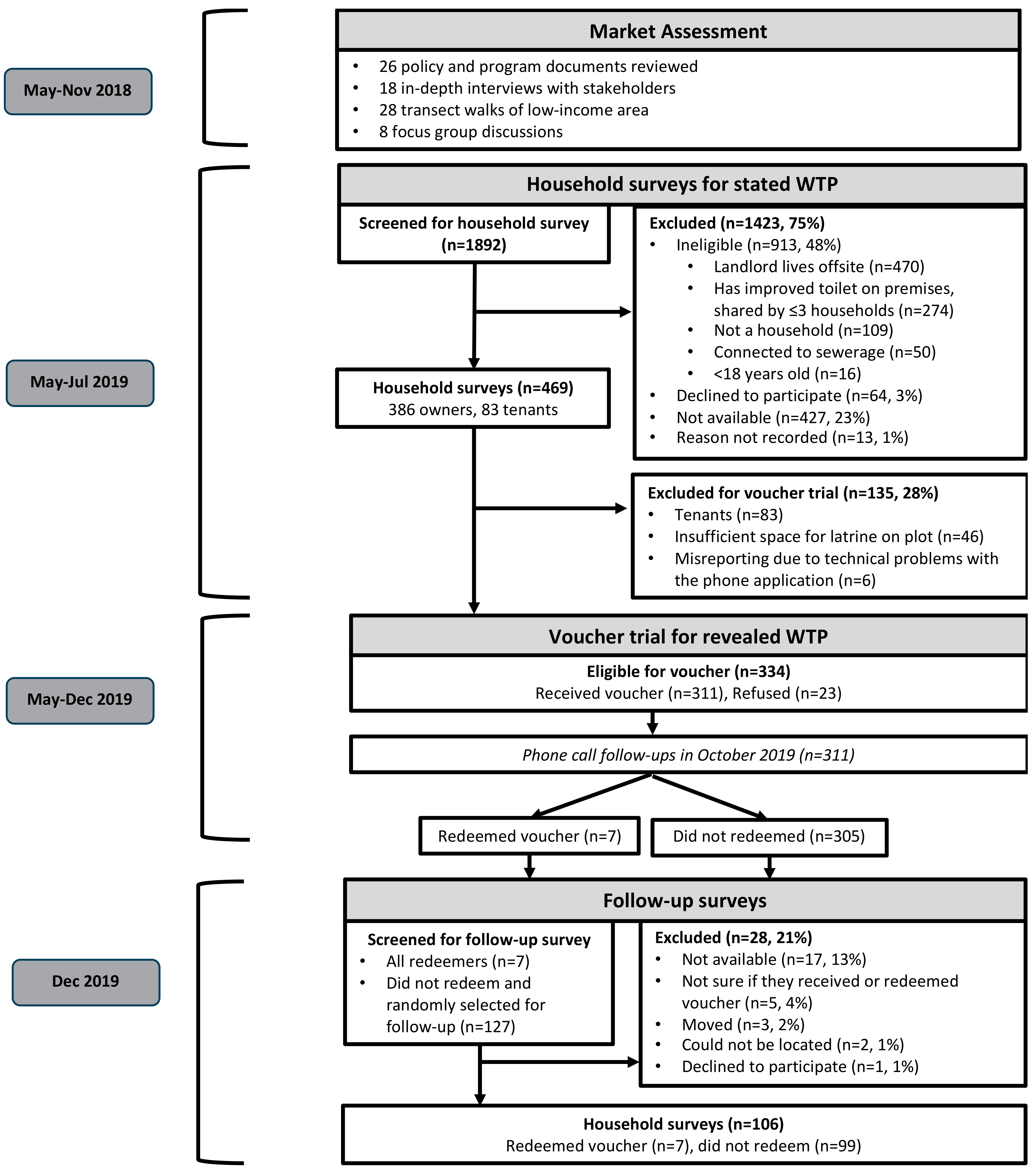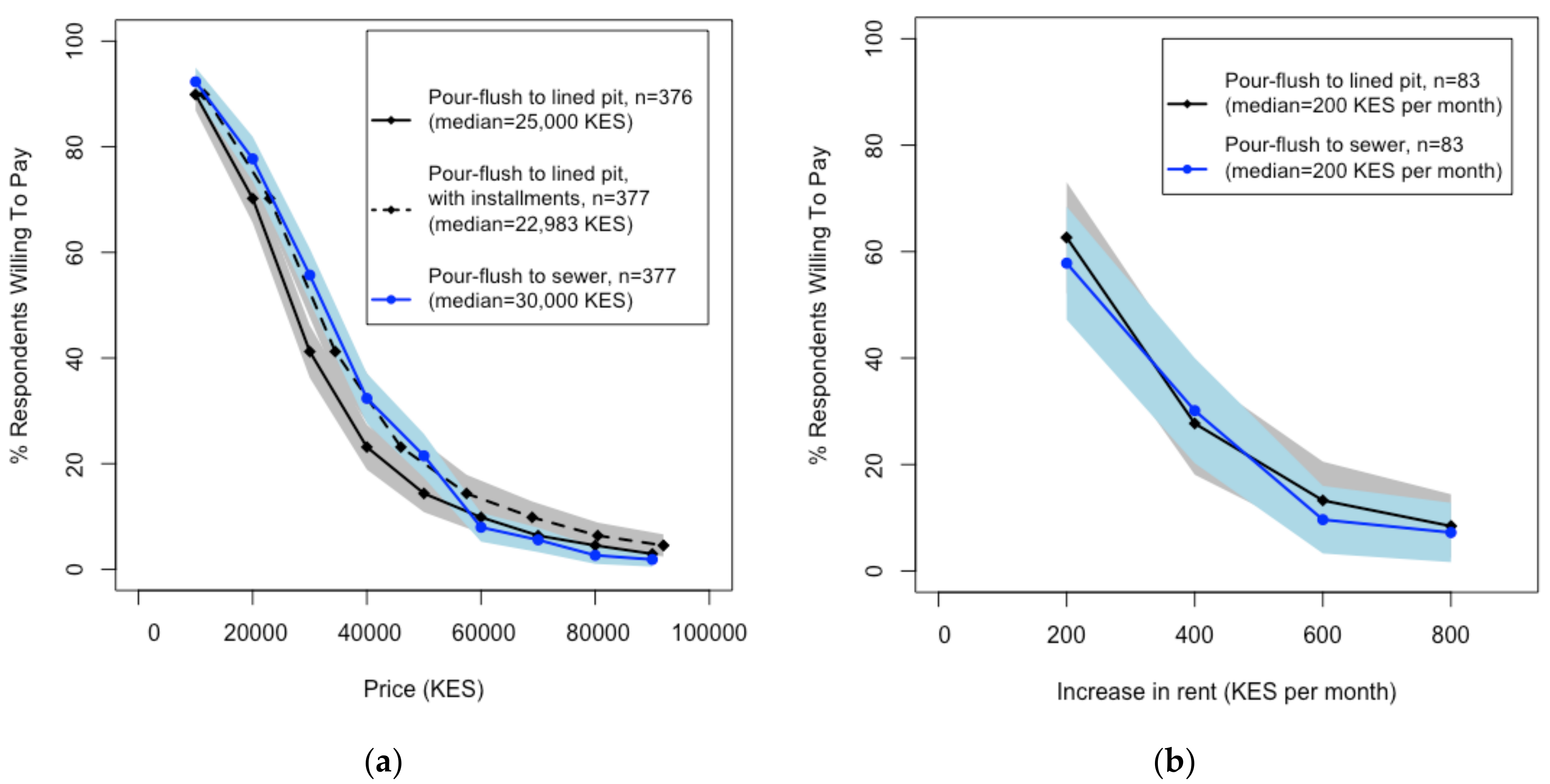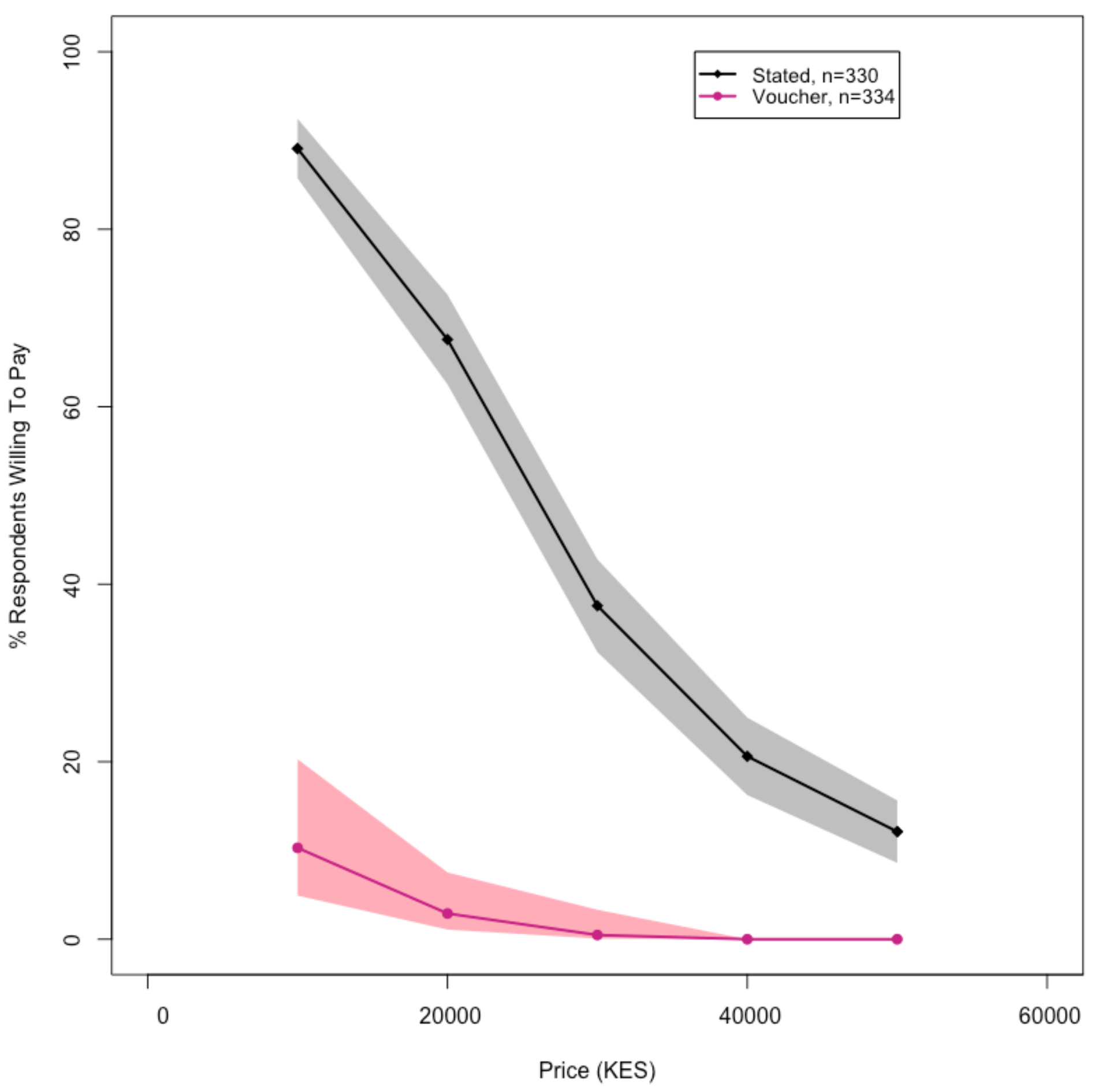Will Households Invest in Safe Sanitation? Results from an Experimental Demand Trial in Nakuru, Kenya
Abstract
1. Introduction
2. Materials and Methods
2.1. Study Site
2.2. Study Design
2.3. High-Quality Latrine Characteristics
2.4. Study Population and Sampling Strategy
2.5. Stated Willingness to Pay
2.6. Revealed Willingness to Pay
2.7. Sample Size
2.8. Data Analysis
3. Results
3.1. Study Population
3.2. Stated WTP
3.3. Revealed WTP
3.4. Exploring Low Voucher Redemption
3.4.1. Financial Constraints
3.4.2. Redemption Process and Trust
3.4.3. Decision-Making Responsibilities
3.4.4. Latrine Design
4. Discussion
5. Conclusions
Supplementary Materials
Author Contributions
Funding
Institutional Review Board Statement
Informed Consent Statement
Data Availability Statement
Acknowledgments
Conflicts of Interest
References
- Fewtrell, L.; Prüss-Ustün, A.; Bos, R.; Gore, F.; Bartram, J. Water, Sanitation and Hygiene: Quantifying the Health Impact at National and Local Levels in Countries with Incomplete Water Supply and Sanitation Coverage; World Health Organization: Geneva, Switzerland, 2007. [Google Scholar]
- Null, C.; Stewart, C.P.; Pickering, A.J.; Dentz, H.N.; Arnold, B.F.; Arnold, C.D.; Benjamin-Chung, J.; Clasen, T.; Dewey, K.G.; Fernald, L.C.H.; et al. Effects of water quality, sanitation, handwashing, and nutritional interventions on diarrhoea and child growth in rural Kenya: A cluster-randomised controlled trial. Lancet 2018, 6, 316–329. [Google Scholar] [CrossRef]
- Prüss-Ustün, A.; Bartram, J.; Clasen, T.; Colford, J.M.; Cumming, O.; Curtis, V.; Bonjour, S.; Dangour, A.D.; De France, J.; Fewtrell, L.; et al. Burden of disease from inadequate water, sanitation and hygiene in low- and middle-income settings: A retrospective analysis of data from 145 countries. Trop. Med. Int. Health 2014, 19, 894–905. [Google Scholar] [CrossRef]
- Wolf, J.; Hunter, P.; Freeman, M.; Cumming, O.; Clasen, T.; Bartram, J.; Higgins, J.; Johnston, R.; Medlicott, K.; Boisson, S.; et al. Impact of Drinking Water, Sanitation and Hand Washing with Soap on Childhood Diarrhoeal Disease: Updated Meta-Analysis and -Regression. Trop. Med. Int. Health 2018, 23, 508–525. [Google Scholar] [CrossRef]
- Khanna, T.; Das, M. Why gender matters in the solution towards safe sanitation? Reflections from rural India. J. Glob. Public Health 2016, 11, 1185–1201. [Google Scholar] [CrossRef] [PubMed]
- WHO/UNICEF JMP. Progress on Household Drinking Water, Sanitation and Hygiene 2000–2017: Special Focus on Inequalities; United Nations Children’s Fund (UNICEF) and World Health Organization (WHO): New York, NY, USA, 2019. [Google Scholar]
- Peletz, R.; Kisiangani, J.; Ronoh, P.; Cock-esteb, A.; Chase, C.; Khush, R.; Luoto, J. Assessing the Demand for Plastic Latrine Slabs in Rural Kenya. Am. J. Trop. Med. Hyg. 2019, 10, 555–565. [Google Scholar] [CrossRef]
- Peletz, R.; Cock-Esteb, A.; Ysenburg, D.; Haji, S.; Khush, R.; Dupas, P. Supply and Demand for Improved Sanitation: Results from Randomized Pricing Experiments in Rural Tanzania. Environ. Sci. Technol. 2017, 51, 7138–7147. [Google Scholar] [CrossRef] [PubMed]
- Balasubramanya, S.; Evans, B.; Hardy, R.; Ahmed, R.; Habib, A.; Asad, N.S.M.; Rahman, M.; Hasan, M.; Dey, D.; Fletcher, L.; et al. Towards sustainable sanitation management: Establishing the costs and willingness to pay for emptying and transporting sludge in rural districts with high rates of access to latrines. PLoS ONE 2017, 12, e0171735. [Google Scholar] [CrossRef]
- Burt, Z.; Sklar, R.; Murray, A. Costs and Willingness to Pay for Pit Latrine Emptying Services in Kigali, Rwanda. Int. J. Environ. Res. Public Health 2019, 16, 4738. [Google Scholar] [CrossRef] [PubMed]
- Peletz, R.; MacLeod, C.; Kones, J.; Samuel, E.; Cock-Esteb, A.; Delaire, C.; Khush, R. When Pits Fill Up: Supply and Demand for Safe Pit-Emptying Services in Kisumu, Kenya. PLoS ONE 2020, 15, e0238003. [Google Scholar] [CrossRef] [PubMed]
- Delaire, C.; Peletz, R.; Haji, S.; Kones, J.; Samuel, E.; Easthope-Frazer, A.; Charreyron, E.; Wang, T.; Feng, A.; Mustafiz, R.; et al. How much will safe sanitation for all cost? Evidence from five cities. Environ. Sci. Technol. 2021, 55, 767–777. [Google Scholar] [CrossRef] [PubMed]
- Andres, L.; Thibert, M.; Lombana, C.; Danilenko, A.; Joseph, G.; Borja-Vega, C. Doing More with Less: Smarter Subsidies for Water Supply and Sanitation; World Bank: Washington, DC, USA, 2019. [Google Scholar]
- Trémolet, S. Sanitation Markets: Using Economics to Improve the Delivery of Services along the Sanitation Value Chain. Pathfinder Paper. 2012. Available online: https://www.ircwash.org/resources/sanitation-markets-using-economics-improve-delivery-services-along-sanitation-value-chain (accessed on 1 April 2021).
- Trémolet, S.; Kolsky, P.; Perez, E. Financing On-Site Sanitation for the Poor: A Six Country Comparative Review; World Bank: Washington, DC, USA, 2010. [Google Scholar]
- Breidert, C.; Hahsler, M.; Reutterer, T. A Review of Methods for Measuring Willingness-to-Pay. Innov. Mark. 2006, 2. [Google Scholar]
- Cummings, C.; Langdown, I.; Hart, T.; Lubuva, J.; Kisela, H. What Drives Reform? Making Sanitation a Political Priority in Secondary Cities; Oversees Development Institute Report: London, UK, 2016. [Google Scholar]
- Mitchell, R.C.; Carson, R.T. Using Surveys to Value Public Goods: The Contingent Valuation Method; Resources for the Future: Washington, DC, USA, 1989. [Google Scholar]
- Whittington, D.; Briscoe, J.; Mu, X.; Barron, W. Estimating the Willingness to Pay for Water Services in Developing Countries: A Case Study of the Use of Contingent Valuation Surveys in Southern Haiti. Econ. Dev. 1990, 38, 293–311. [Google Scholar] [CrossRef]
- Furlong, C. SFD Report Nakuru, Kenya; SFD Promotion Initiative, 2015. Available online: https://www.susana.org/_resources/documents/default/3-2390-7-1450196561.pdf (accessed on 1 April 2021).
- MajiData Majidata—The Database for the Kenyan Water Sector. Available online: http://majidata.go.ke/ (accessed on 1 April 2019).
- Acey, C.; Kisiangani, J.; Ronoh, P.; Delaire, C.; Makena, E.; Norman, G.; Levine, D.; Khush, R.; Peletz, R. Cross-subsidies for improved sanitation in low income settlements: Assessing the willingness to pay of water utility customers in Kenyan cities. World Dev. 2019, 115, 160–177. [Google Scholar] [CrossRef]
- WSUP. High-Quality Shared Sanitation: How Can We Define That? Water & Sanitation for the Urban Poor, 2018. Available online: https://www.wsup.com/insights/high-quality-shared-sanitation-how-can-we-define-that/ (accessed on 1 April 2021).
- WHO/UNICEF. Safely Managed Drinking Water: Thematic Report on Drinking Water 2017; World Health Organization: Geneva, Switzerland, 2017. [Google Scholar]
- Aquaya Institute; WSUP. Sanitation Policies, Practices and Preferences in Nakuru, Kenya; The Aquaya Institute, 2019. Available online: https://aquaya.org/sanitation-policies-practices-and-preferences-in-nakuru-kenya/ (accessed on 1 April 2021).
- Simiyu, S.; Swilling, M.; Rheingans, R.; Cairncross, S. Estimating the Cost and Payment for Sanitation in the Informal Settlements of Kisumu, Kenya: A Cross-sectional Study. Int. J. Environ. Res. Public Health 2017, 14, 49. [Google Scholar] [CrossRef]
- Kumpel, E.; Albert, J.; Peletz, R.; De Waal, D.; Hirn, M.; Danilenko, A.; Uhl, V.; Daw, A.; Khush, R. Urban water services in Fragile States: An analysis of drinking water sources and quality in port Harcourt, Nigeria, and Monrovia, Liberia. Am. J. Trop. Med. Hyg. 2016, 95, 229–238. [Google Scholar] [CrossRef] [PubMed]
- Foreit, J.; Foreit, K. The Reliability and Validity of Willingness-to-pay Surveys for Reproductive Health Pricing Decisions in Developing Countries. Health Policy 2003, 63, 37–47. [Google Scholar] [CrossRef]
- Altaf, M.A.; Hughes, J. Measuring the Demand for Improved Urban Sanitation Services: Results of a Contingent Valuation Study in Ouagadougou, Burkina Faso. Urban Stud. 1994, 31, 1763–1776. [Google Scholar] [CrossRef]
- Gunatilake, H.; Yang, J.-C.; Pattanayak, S.; Choe, K.A. Good Practices for Estimating Reliable Willingness-to-Pay Values in the Water Supply and Sanitation Sector; Asian Development Bank: Manila, Philippines, 2007. [Google Scholar]
- Hanemann, M.; Loomis, J.; Kanninen, B.; Hanemann, M.; Loomis, J.; Kanninen, B. Statistical Efficiency of Dichotomous Choice Contingent Valuation. Am. J. Agric. Econ. 1991, 73, 1255–1263. [Google Scholar] [CrossRef]
- R Core Team. R: A Language and Environment for Statistical Computing. 2019. Available online: https://www.gbif.org/tool/81287/r-a-language-and-environment-for-statistical-computing (accessed on 1 February 2020).
- Mansour, G.; Oyaya, C.; Owor, M. Situation Analysis of the Urban Sanitation Sector in Kenya; 2017; Available online: https://www.wsup.com/content/uploads/2017/09/Situation-analysis-of-the-urban-sanitation-sector-in-Kenya.pdf (accessed on 1 April 2021).
- Tidwell, J.B.; Terris-prestholt, F.; Quaife, M.; Aunger, R. Understanding demand for higher quality sanitation in peri-urban Lusaka, Zambia through stated and revealed preference analysis. Soc. Sci. Med. 2019, 232, 139–147. [Google Scholar] [CrossRef]
- Schmidt, J.; Bijmolt, T.H.A. Accurately measuring willingness to pay for consumer goods: A meta-analysis of the hypothetical bias. J. Acad. Mark. Sci. 2019, 48, 499–518. [Google Scholar] [CrossRef]
- Ahlheim, M. Contingent valuation and the budget constraint. Ecol. Econ. 1998, 27, 205–211. [Google Scholar] [CrossRef]
- Tidwell, J.B. Users are willing to pay for sanitation, but not as much as they say: Empirical results and methodological comparisons of willingness to pay for peri-urban sanitation in lusaka, zambia using contingent valuation, discrete choice experiments, and hedonic p. J. Water Sanit. Hyg. Dev. 2020, 10, 756–767. [Google Scholar] [CrossRef]
- Musalia, J. Household Decision Making Among Married Women in Kenya: A Latent Class Analysis. Sex Roles 2018, 78, 182–193. [Google Scholar] [CrossRef]
- NAWASSCO. Up-scaling of Basic Sanitation for the Urban Poor (UBSUP). Available online: https://www.susana.org/en/knowledge-hub/resources-and-publications/susana-publications/details/2861 (accessed on 1 February 2020).
- Schröder, E. Upscaling Basic Sanitation for the Urban Poor (UBSUP) in Kenya; Sustainable Sanitation Alliance: Nairobi, Kenya, 2016. [Google Scholar]
- Nakuru County Sanitation Programme. Sanitation Value Chain: Unlocking Opportunities in Sanitation; Nakuru County Sanitation Programme and Egerton University: Njoro, Kenya, 2018. [Google Scholar]



| Safe Sanitation Option | Respondent 1 | Full Price | Price Points (Ranging from 80% to 10% Discounts) |
|---|---|---|---|
| Pour-flush to lined pit (pit + slab + superstructure) | Landlords/ homeowners | 87,100 KES | (5000); 10,000; 20,000; 30,000; 40,000; 50,000; 70,000; (90,000) KES |
| Pour-flush to sewer (sewer connection + slab + superstructure) | Landlords/ homeowners | 82,900 KES | (5000); 10,000; 20,000; 30,000; 40,000; 50,000; 70,000; (90,000) KES |
| Pour-flush to lined pit (pit + slab + superstructure), in installments | Landlords/ homeowners | 9000 KES 1 per month | (500); 1000; 2000; 4000; 3000; 5000; 7000; (9000) KES per month |
| Both pour-flush options (increased rent) | Tenants | Variable 2 | (100), 200, 400, 600, 800, (900) KES per month |
| Category | All Respondents (n = 469) 1 | Voucher Eligible Respondents (n = 334) 2 | Voucher Redeemers (n = 7) |
|---|---|---|---|
| Gender (% female) | 67% | 66% | 57% |
| Median 3 age | 42 (32–54) | 45 (34–55) | 44 (30–55) |
| Education | |||
| Less than primary | 19% | 21% | 14% |
| Primary | 38% | 41% | 43% |
| Secondary | 32% | 27% | 29% |
| Above secondary | 12% | 11% | 14% |
| Married or in union | 69% | 68% | 57% |
| Median 3 household size | 4 (3–6) | 5 (3–6) | 6 (5–6) |
| Presence of children under five years | 40% | 36% | 29% |
| Presence of physically challenged persons | 9% | 12% | 14% |
| Respondent type | |||
| Tenants | 18% | NA | NA |
| Homeowners with no tenants | 48% | 65% | 57% |
| Landlords | 34% | 35% | 43% |
| Median 3 number of households sharing a compound | 1 (1–8) | 1 (1–6) | 1 (1–8) |
| Median 3 number of years lived in the compound | 12 (4–20) | 15 (8–24) | 14 (12–22) |
| Primary source of water | |||
| Piped to compound | 51% | 46% | 43% |
| Piped outside compound | 16% | 15% | 0% |
| Non-piped in compound | 14% | 16% | 0% |
| Non-piped outside compound | 19% | 23% | 57% |
| Have to pay to use primary water source | 88% | 87% | 86% |
| Sanitation | |||
| Improved latrine shared by up to three households | 8% | 7% | 14% |
| Improved latrine shared by more than three households | 32% | 17% | 29% |
| Unimproved latrine | 53% | 66% | 57% |
| No latrine in compound | 7% | 10% | 0% |
| Median 3 number of households sharing one latrine | 1 (1–9) | 1 (1–4) | 1 (1–4) |
| Satisfied with the current sanitation 4 | 43% | 31% | 0% |
| Monthly household income (KES) | |||
| <3000 | 9% | 11% | 0% |
| 3000–5000 | 18% | 18% | 43% |
| 5000–7000 | 13% | 13% | 14% |
| 7000–10,000 | 20% | 19% | 14% |
| 10,000–23,000 | 28% | 27% | 14% |
| 23,000–50,000 | 11% | 10% | 14% |
| >50,000 | 2% | 2% | 0% |
| About landlords | |||
| n | 159 | 117 | 3 |
| Median 3 number of dwellings owned | 9 (5–14) | 9 (5–14) | 7 (7–17) |
| Median 3 monthly rent collected (KES) | 10,000 (4900–23,000) | 10,000 (4000–22,000) | 15,000 (11,700–28,500) |
| About tenants | NA | NA | |
| n | 83 | ||
| Median 3 monthly rent paid (KES) | 2000 (1200–2500) |
| Number (n = 99) | Percentage | |
|---|---|---|
| Voucher status | ||
| Still have it 1 | 85 | 86% |
| Lost it | 5 | 5% |
| Gave it away | 1 | 1% |
| Don’t know | 8 | 8% |
| Who decided not to redeem | ||
| Male respondent | 17 | 17% |
| Female respondent | 48 | 48% |
| Male spouse | 26 | 26% |
| Female spouse | 3 | 3% |
| Another family member | 18 | 18% |
| Nobody (waiting for follow up) | 7 | 7% |
| Why they didn’t redeem the voucher | ||
| Didn’t have the money/other spending priorities | 68 | 67% |
| Price was too high | 12 | 12% |
| Unsure how to redeem | 8 | 8% |
| Not my decision | 7 | 7% |
| Thought voucher was fraudulent | 5 | 5% |
| Other 2 | 18 | 18% |
| Spent money on latrine construction/upgrades in last six months | ||
| No | 76 | 77% |
| Modifications 3 to existing latrine | 21 | 21% |
| Started building new dry pit latrine | 2 | 2% |
| Big expenditures in the past three months | ||
| School fees | 42 | 42% |
| Medical expenses | 39 | 39% |
| Ceremonies (funeral, marriage, initiation) | 14 | 14% |
| House construction/repairs | 11 | 11% |
| Water | 6 | 6% |
| Fertilizer/agriculture | 5 | 5% |
| Other 4 | 19 | 19% |
| None | 17 | 17% |
| Household spending priorities if they earned an extra 1500 KES per week | ||
| Savings | 49 | 49% |
| Small business/Agriculture | 41 | 41% |
| Household construction/upgrades | 29 | 29% |
| Food | 23 | 23% |
| School fees | 21 | 21% |
| Healthcare | 10 | 10% |
| Clothes | 6 | 6% |
| Other 5 | 21 | 18% |
| Recommendations to increase voucher redemption 6 | ||
| Conduct more follow-ups/reminders | 32 | 35% |
| Build demonstration latrine | 32 | 34% |
| Provide more time for redemption | 24 | 26% |
| Provide more explanation of sanitation benefits | 23 | 25% |
| Convene community meetings | 15 | 16% |
| Lower the price or provide for free | 11 | 12% |
| Allow for monthly installments | 10 | 11% |
| Involve the municipal utility (NAWASSCO) or public health officers | 5 | 5% |
| Other 7 | 8 | 9% |
Publisher’s Note: MDPI stays neutral with regard to jurisdictional claims in published maps and institutional affiliations. |
© 2021 by the authors. Licensee MDPI, Basel, Switzerland. This article is an open access article distributed under the terms and conditions of the Creative Commons Attribution (CC BY) license (https://creativecommons.org/licenses/by/4.0/).
Share and Cite
Peletz, R.; Delaire, C.; Kones, J.; MacLeod, C.; Samuel, E.; Easthope-Frazer, A.; Khush, R. Will Households Invest in Safe Sanitation? Results from an Experimental Demand Trial in Nakuru, Kenya. Int. J. Environ. Res. Public Health 2021, 18, 4462. https://doi.org/10.3390/ijerph18094462
Peletz R, Delaire C, Kones J, MacLeod C, Samuel E, Easthope-Frazer A, Khush R. Will Households Invest in Safe Sanitation? Results from an Experimental Demand Trial in Nakuru, Kenya. International Journal of Environmental Research and Public Health. 2021; 18(9):4462. https://doi.org/10.3390/ijerph18094462
Chicago/Turabian StylePeletz, Rachel, Caroline Delaire, Joan Kones, Clara MacLeod, Edinah Samuel, Alicea Easthope-Frazer, and Ranjiv Khush. 2021. "Will Households Invest in Safe Sanitation? Results from an Experimental Demand Trial in Nakuru, Kenya" International Journal of Environmental Research and Public Health 18, no. 9: 4462. https://doi.org/10.3390/ijerph18094462
APA StylePeletz, R., Delaire, C., Kones, J., MacLeod, C., Samuel, E., Easthope-Frazer, A., & Khush, R. (2021). Will Households Invest in Safe Sanitation? Results from an Experimental Demand Trial in Nakuru, Kenya. International Journal of Environmental Research and Public Health, 18(9), 4462. https://doi.org/10.3390/ijerph18094462






